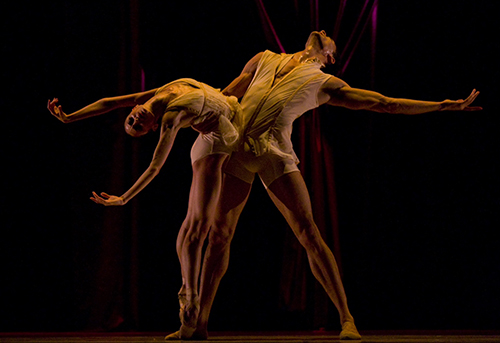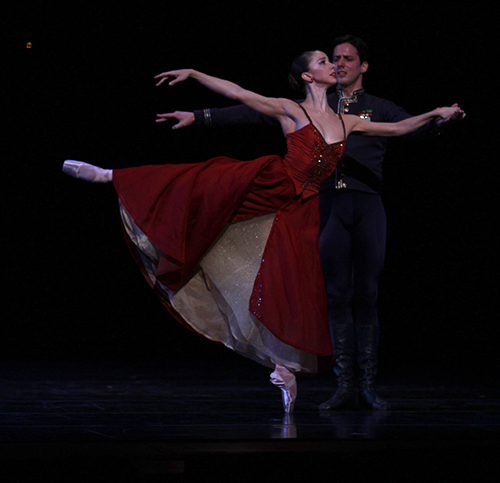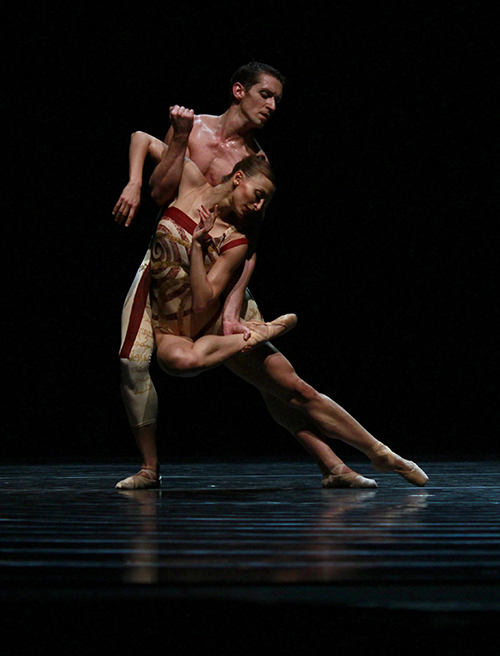 Victoria Jaiani and Fabrice Calmels in Age of Innocence, choreographed by Edwaard Liang, Photo by Herbert Migdoll.
Victoria Jaiani and Fabrice Calmels in Age of Innocence, choreographed by Edwaard Liang, Photo by Herbert Migdoll.
Love, longing and sensuality are at the core of the Joffrey Ballet's "Spring Desire" program which opened Wednesday night at Chicago's Auditorium Theatre. The three neo-classical works on the program include the critically acclaimed Age of Innocence by Edwaard Liang, In the Night by the celebrated choreographer Jerome Robbins and the world premiere of Incantations by Val Caniparoli.
Set to the music of Philip Glass and Thomas Newman, Age of Innocence opens the evening with its tense, formal underpinnings -- expertly juxtaposed with moments of passion and the yearning to express that which is in the heart. Maria Pinto's thoughtful costume design cements the 18th/19th century vibe without being too literal, and enormous red velvet curtains are the only backdrop needed to evoke a formal ballroom atmosphere that is filled with both grandeur and repressed emotion.
To begin, the dancers dutifully line up, men on one side, women on the other. Hands extend and are accepted gracefully, but the hidden dialogue of which dancers long for one another remains frozen beneath the surface -- cloaked in ritual. The First Dialogue sequence gives a first glimpse of that ache, when Jeraldine Mendoza and Mauro Villanueva suddenly find themselves involved a spinning, romantic match that transcends the rules of courting.
The next sequence, titled simply, The Men, is indeed a powerful display of manliness, executed with verve and confidence by Raul Casasola, Aaron Rogers, Ricardo Santos and Temur Suluashvili. The highlight of the piece, however, was most certainly Victoria Jaiani and Fabrice Calmels, who treated the audience to a riveting performance in the Obey Thee sequence.
 April Daly and Miguel Angel Blanco in In the Night, choreographd by Jerome Robbins, Photo by Herbert Migdoll.
April Daly and Miguel Angel Blanco in In the Night, choreographd by Jerome Robbins, Photo by Herbert Migdoll.
Next up was In the Night, an enchanting look at love, choreographed by Jerome Robbins in 1970. This timeless piece consists of three pas de deux that explore relationships which are all in very different places. The backdrop provides a guide to the pulse of each pairing, with sparkling stars for young romance, formal chandeliers denoting a more guarded partnership and shooting stars to illuminate the tumultuous union that runs both hot and cold. More traditional in style than either of the other two pieces, this is Robbins at his finest, and the dancers rise to the occasion here. Set to the music of Chopin, pianist Paul James Lewis provided flawless live accompaniment for the piece.
 Joanna Wozniak and Matthew Adamczyk in Incantations, choreographer by Val Caniparoli, Photo by Herbert Migdoll.
Joanna Wozniak and Matthew Adamczyk in Incantations, choreographer by Val Caniparoli, Photo by Herbert Migdoll.
As the curtain rose to reveal the world premiere of Incantations, a visual clue provided a hint as to what the audience was about to see. Hanging high on the right-hand side of the stage loomed a group of large spring-like fixtures that are reminiscent of beehives -- a harbinger of what was to come in the choreography. Almost immediately, dancers began to flash across the stage with lightning speed, performing unusual sequences of movement -- some of which are staggeringly difficult and wonderfully complex. Indeed, nearly the entire piece was infused with a buzzing, almost erratic energy that keeps building, lending a rather "showy" feel to much of the performance.
Occasionally there was a lapse in timing, yet all was immediately forgiven when the next cycle of intricate movements began. Some of the swirling motions seemed almost like a nervous habit after a while, but overall it was the continuous motion and energy that really took center stage. The music of Russian minimalist composer Alexandre Rabinovitch-Barakovsky and spectacular lighting design by Lucy Carter added both frenzy and focus to the work.
Although splendidly athletic, Incantations rides along the edge of being tiring for the viewer; but just when the piece threatens to overwhelm, release was finally granted through the absolutely glorious pairing of Joanna Wozniak and Matthew Adamczyk, which transformed the piece both in mood and motion. Here Caniparoli takes the dancers down from a mindless, wild energy to a softer exploration that still offers complexity paired with exquisite skill. The duet finishes in a seamless whirling motion that echoes the earlier chaos -- but in a much more forgiving fashion.
Performances through May 6th at the Auditorium Theatre.
This article first appeared on 4dancers.org
